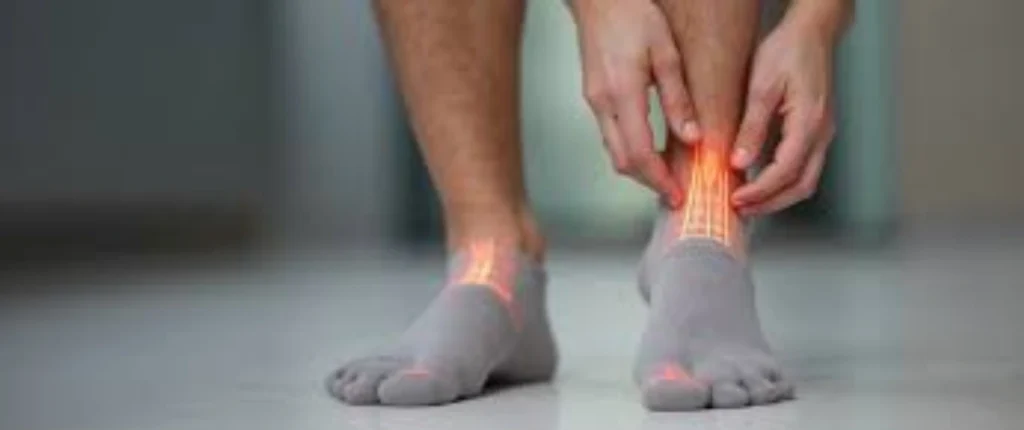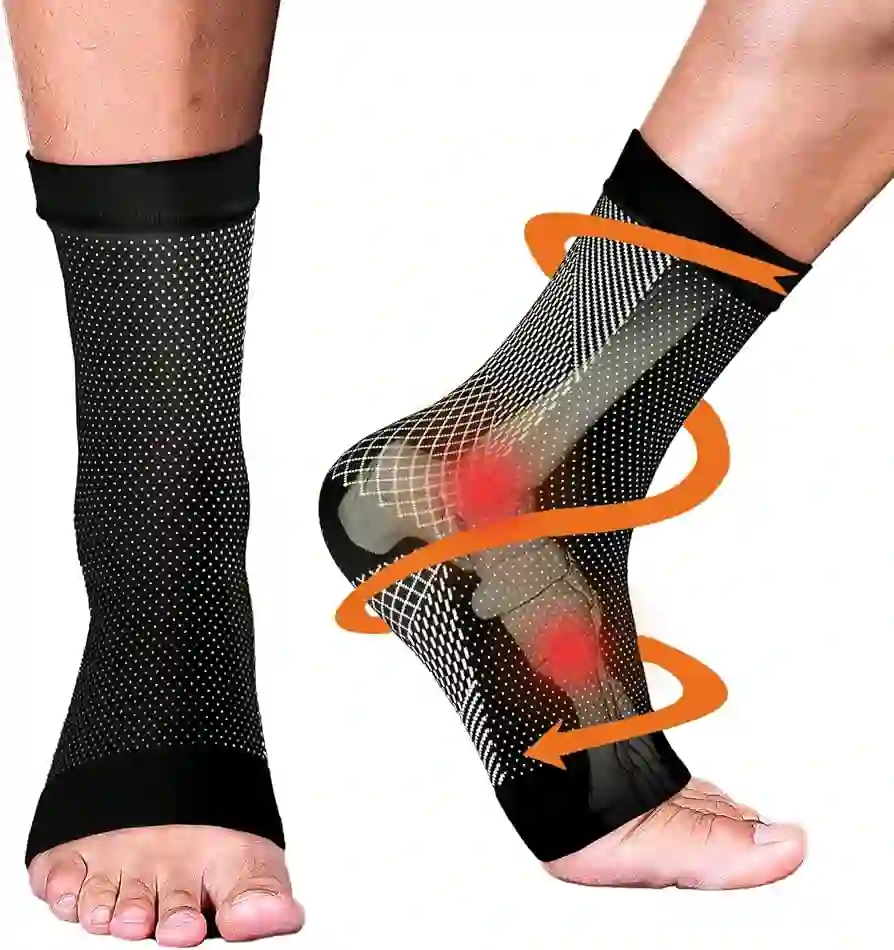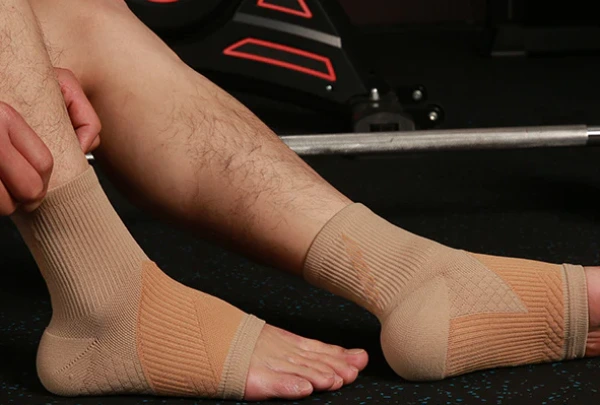Introduction: Why Neuropathy Socks Matter in Medical Product Sourcing
The market is crowded with socks claiming to relieve foot pain—but for people living with peripheral neuropathy, this isn’t a comfort accessory. It’s medical-grade protection. For procurement teams at medical supply companies, orthopedic brands, and retailers, choosing the right neuropathy sock isn’t optional—it’s essential.

Done right, it builds brand trust and serves a high-need segment. Done wrong, it risks customer dissatisfaction, returns, and brand damage. This guide offers a full technical and strategic overview of what to look for in neuropathy sock manufacturing—from material performance to production partnerships. If your business is preparing to expand or refine its medical sock offering, this resource will walk you through every stage of smart sourcing.
What Exactly Are Neuropathy Socks and How Do They Work?
Neuropathy socks are specialized medical hosiery designed to protect individuals with peripheral nerve damage—often caused by diabetes—from injuries, pressure points, and circulation issues. For procurement teams sourcing effective solutions, understanding how these socks function is key to evaluating quality and manufacturing partners.
Core Functions:
- Protection: Shields sensitive feet from internal friction and external impact.
- Comfort: Eliminates seams or irritants that could harm numb or hypersensitive skin.
- Circulation: Promotes blood flow with non-binding, pressure-distributing cuffs.
Key Technical Features:
- Seamless Toe Design: Reduces friction and lowers the risk of ulcer formation.
- Non-Binding Tops: Stay up without constricting the calf, minimizing circulation problems.
- Targeted Padding: Cushion zones at pressure points absorb shock and reduce injury risk.
These design elements are not cosmetic—they are clinically informed engineering decisions that directly impact user safety. When evaluating neuropathy sock manufacturers, these components should form the foundation of your product specification checklist.
Who Is the Primary Market for Neuropathy Socks?
Neuropathy socks serve a diverse range of end-users. For brand and product teams, understanding these groups is essential for positioning, product design, and channel strategy.
Diabetic Patients
With over 37 million Americans living with diabetes, and nearly half at risk of neuropathy, this is the core market. These consumers actively seek podiatrist-approved, medically functional socks—creating stable demand for certified, protective designs.
Chemotherapy Patients
CIPN (Chemotherapy-Induced Peripheral Neuropathy) causes acute foot sensitivity. This group values ultra-soft, seamless socks that minimize irritation. Medical brands serving oncology departments or recovery centers can meet a real, underserved need.
Seniors & Aging Adults
Age-related circulation issues, swelling, and sensitivity increase demand for easy-on, non-binding, padded socks. Positioning through pharmacies, eldercare retailers, or wellness catalogs opens strong B2B distribution potential.
Niche Neuropathy Populations
This includes those with fibromyalgia, injury-induced nerve damage, or idiopathic neuropathy. While smaller, this collective group represents a meaningful secondary market with specialized comfort needs.
Together, these segments offer high-value, recurring demand across both healthcare and wellness categories.
What Are the Key Differences Between Neuropathy Socks and Regular Socks?
Neuropathy socks differ from regular socks in four key ways—each engineered for protection, not just comfort.
Seamless Toe Construction
Standard socks often feature raised seams, especially across the toe line. For individuals with neuropathy, these seams can cause constant irritation or even skin breakdown. Therapeutic socks use flat-linked or Rosso toe closures to eliminate friction points, ensuring a smooth surface for sensitive feet.
Non-Constrictive Cuff Design
Regular cuffs rely on tight elastic to prevent slippage, often leaving deep red marks. Neuropathy socks use a honeycomb or cross-stitch pattern that gently holds the sock in place without restricting circulation—critical for those with swelling or compromised blood flow.
Medical-Grade Materials
Whereas common socks might use basic cotton or synthetic blends, neuropathy socks prioritize moisture-wicking, softness, and low friction. Materials like bamboo, merino wool, modal, or technical yarns help maintain a dry, non-abrasive environment, reducing the risk of fungal infections.
Targeted Cushioning
Regular socks have uniform thickness, but neuropathy socks offer reinforced padding at high-pressure zones like the heel and forefoot. This extra protection helps absorb impact, redistribute pressure, and lower the risk of ulcers or foot injuries.
Each of these design elements transforms the sock from a generic garment into a medical-grade product that safeguards foot health in high-risk users.
What Are the Most Crucial Features to Look for in High-Quality Neuropathy Socks?
When evaluating suppliers, these technical features should be on every checklist. They’re not just nice to have—they’re essential to performance, comfort, and patient safety.
Seamless Toe Construction
This is non-negotiable. Friction from internal seams causes blistering and injuries in neuropathy patients. A proper seamless toe should feel smooth when turned inside out—no ridges, bumps, or threads.
Non-Constricting Fit
The sock must stretch to accommodate swelling without sagging. Look for balanced Lycra or spandex content and a graduated knit that keeps the sock up without compression. Fit should feel invisible yet supportive.
Moisture-Wicking Materials
Dry feet are critical for infection prevention. Prioritize fibers like polyester, nylon, bamboo, or merino wool that actively move sweat away from the skin. Moisture control reduces the risk of fungal infections and skin breakdown.
Targeted Cushioning
Generic padding won’t do. Focused terry loop cushioning under the ball of the foot and heel protects weight-bearing areas. This design reduces pressure points and supports long wear inside shoes.
Antimicrobial Yarn Options
For premium models, consider integrating silver or copper-infused yarns. These offer odor resistance and bacterial protection, supporting both hygiene and high-end positioning.
These five features define what sets apart a top-tier neuropathy sock. Brands serious about safety, comfort, and credibility should make them standard in their product specs and supplier evaluation criteria.
Which Materials Are Best for Manufacturing Neuropathy Socks?
For neuropathy socks, yarn selection isn’t cosmetic—it’s critical. The right material directly affects softness, skin tolerance, moisture control, and long-wear comfort. Below are key materials commonly used in performance medical socks, each suited for different levels of product positioning.

Natural fibers ensure softness for sensitive skin:
- Bamboo Rayon offers a silk-like feel with breathable, antibacterial properties. It’s ideal for entry- to mid-tier product lines.
- Merino Wool provides temperature regulation and moisture absorption, suitable for premium winter or all-season options.
Synthetic fibers are essential for moisture and structural support:
- Polyester/Nylon enable rapid moisture-wicking, reducing friction and infection risk—ideal for daily wear socks.
- Spandex/Lycra ensures gentle stretch without constriction, improving fit and preventing sock slippage.
Infused yarns target hygiene and therapeutic value:
- Copper-infused yarn helps control odor and bacteria.
- Silver-based fibers (e.g., X-STATIC®) deliver stronger antimicrobial action and temperature regulation—suitable for top-tier or specialized medical lines.
Choosing a blend of these materials allows manufacturers to tailor neuropathy socks by usage case, patient needs, and price tier, helping brands deliver effective, scalable solutions.
How Does Mild Compression Factor into Neuropathy Socks?
Compression is often misunderstood. When most people hear the term, they picture tight medical-grade stockings used to treat serious circulatory issues. However, in neuropathy socks, the compression applied is gentle—typically in the 8–15 mmHg range—and designed for comfort, not clinical intervention.
This mild graduated compression supports circulation by applying the most pressure at the ankle, gradually decreasing up the leg. It helps reduce mild edema (swelling in the lower limbs), which is common in neuropathy patients and often contributes to discomfort, shoe tightness, and fatigue.
The result? Improved foot and leg comfort throughout the day. For end users who suffer both nerve pain and swelling, this dual-action sock offers a strong value proposition—comfort plus support in one product. Brands can segment their offering by positioning this as a premium upgrade over standard neuropathy socks, appealing to a broader range of clinical symptoms and consumer needs.
From a manufacturing standpoint, this feature introduces complexity. Achieving consistent compression levels requires specialized knitting technology, precise yarn selection, and strict quality control. Manufacturers must have proven capabilities in graduated compression production, or risk creating products that are either ineffective or potentially unsafe for neuropathy patients.
When evaluating suppliers, ask about compression testing protocols, previous experience with graduated pressure designs, and sampling processes. In short: mild compression can be a differentiating feature—but only when executed with precision.
What Customization Options Can Brands Offer for Neuropathy Socks?
Once technical features are finalized, customization becomes the next strategic step. Effective branding not only enhances shelf appeal but also strengthens customer trust and recall—especially in medical-wellness categories.
Visual Design & Brand Identity
Though performance comes first, design matters. Offering classic shades like black, grey, and navy ensures universal appeal, while calm, wellness-oriented tones (e.g., soft blue or sand) can strengthen brand positioning. Some manufacturers allow subtle patterns, but ensure they don’t affect stretch or internal comfort.
Brand Integration
Logo placement is critical. Premium brands often choose Jacquard knit logos—woven directly into the sock for durability and a professional appearance. More economical options like heat transfers are possible but may reduce perceived value and comfort.
Packaging That Sells
Don’t overlook packaging. Branded sock bands, header cards, or retail-ready boxes can reinforce product quality, communicate technical benefits, and highlight certifications—turning packaging into a trust-building asset at point-of-sale.
Functional Customization
For deeper differentiation, collaborate on features like custom grip patterns, proprietary fiber blends (e.g., bamboo + silver for antimicrobial function), or varied cushioning levels for different use cases (light for daily wear, heavy for recovery). These tweaks help you develop a full line tailored to distinct customer segments.
How Should Neuropathy Socks Be Marketed to End Consumers?
Marketing neuropathy socks isn’t about style—it’s about trust and clear communication. Customers aren’t buying comfort. They’re buying relief from pain, swelling, and the fear of foot injury.
Lead with empathy and solutions.
Start by addressing specific problems: numbness, blisters, slow wound healing. Then present product features as precise solutions. Say, “Seamless toes prevent friction sores,” not just “soft fabric.”
Educate, don’t assume.
Most customers don’t know what “moisture-wicking” or “non-binding cuff” actually means. Use visuals, short videos, or interactive diagrams to show how these features protect foot health. Content marketing isn’t optional—it’s the key.
Use targeted messaging.
Tailor campaigns by segment. A senior with edema needs different benefits than a younger diabetic or chemo patient. Customize landing pages and ad content to reflect these needs.
Build credibility.
Highlight certifications like OEKO-TEX®. Share testimonials that speak to specific benefits—real quotes build more trust than generic claims.
What Quality Control Standards Are Essential When Sourcing Neuropathy Socks?
For any brand targeting sensitive-foot users, consistent quality isn’t optional—it’s a baseline requirement. In therapeutic categories like neuropathy socks, QC protocols are directly tied to brand safety, regulatory risk, and product credibility. Here’s the structured framework buyers should enforce:
Certification Requirements
- OEKO-TEX® Standard 100: Mandatory to verify that yarns and dyes are non-toxic and safe for long-term skin contact.
- ISO 9001 Certification: Confirms that the factory operates under a documented, traceable quality management system.
In-Production Quality Checks
- Seam Integrity Control: Inspect toe closures regularly to ensure flat, irritation-free seams.
- Size Compliance Audits: Pull samples by batch to check sock length, leg height, and cuff circumference.
- Elasticity Testing: Stretch and recovery tests on cuffs to confirm non-binding grip maintains performance across wear cycles.
Final Shipment Validation (AQL)
Every bulk order should undergo an AQL (Acceptable Quality Limit) inspection before shipment. This statistical sampling method assesses random finished goods for defects—cosmetic, dimensional, or structural. Failing batches are reworked or held. Reliable manufacturers will already include AQL checks in their process and invite buyer-side participation.
A factory without these standards puts your product—and your reputation—at risk. Insist on transparency, verification, and consistent execution.ion run and is your last line of defense against shipping a subpar product to your customers. A great manufacturing partner won’t just accommodate this; they will welcome it as part of their own quality assurance process.
How Do Neuropathy Socks Differ from Standard Diabetic Socks?
The terms “neuropathy socks” and “diabetic socks” are often used interchangeably, but there are important distinctions. Both prioritize protecting sensitive feet with features like non-binding tops, seamless toes, moisture-wicking fabrics, and padding to prevent injury.
Diabetic socks focus mainly on prevention. Their design aims to reduce risks like blisters, ulcers, and infections by creating a low-friction, low-moisture environment that protects fragile circulation and skin.
Neuropathy socks include these protective elements but add features targeting nerve pain relief. They often have thicker or strategically placed cushioning to soothe aching feet and may use infused fibers like copper or silver for antimicrobial and potential anti-inflammatory effects. Mild graduated compression is common, helping reduce swelling and discomfort associated with neuropathy.
For brands, this difference allows a tiered product approach: market diabetic socks as essential, everyday protection and neuropathy socks as advanced options for active relief. This strategy helps guide customers toward the product that best matches their needs, whether prevention, comfort, or both.
What Is the Role of Padding and Cushioning in Neuropathy Sock Design?
Effective padding in neuropathy socks serves three critical functions—protecting against unseen injuries, reducing friction and shear, and redistributing pressure—and relies on specialized manufacturing techniques for lasting performance.
Protection Against Unfelt Injuries
People with neuropathy may not detect small objects inside shoes. Even a tiny pebble can cause blisters, open sores, or ulcers. Dense sole cushioning creates a barrier that envelops debris, neutralizing sharp pressure points before they damage skin.
Friction and Shear Reduction
Inside the shoe, friction (rubbing) and shear (stretching/tearing) forces threaten skin integrity. Terry-loop cushioning provides a soft, low-friction surface that absorbs movement forces, allowing the foot to shift slightly without chafing and dramatically reducing blister risk.
Targeted Pressure Redistribution
Weight concentrates on the heel at heel strike and the ball of the foot during push-off. In numb feet, these “hot spots” can break down tissue. High-density padding in these zones acts like a custom orthotic, spreading load across the entire sole to lower peak pressures.
Manufacturing Insight: High-Density Terry Loop
The best cushioning comes from terry-loop knitting, which forms thousands of small yarn loops inside the sock. This method outperforms bulkier yarns by:
- Absorbing moisture effectively
- Delivering superior shock absorption
- Maintaining resilience through repeated washes
When evaluating manufacturers, ask about their terry-loop density options and loop-height specifications. This ensures you get the protective, durable cushioning essential for neuropathy socks that truly safeguard vulnerable feet.
How Can Brands Partner with a Manufacturer to Develop a Successful Neuropathy Sock Line?
Choosing the right manufacturing partner is essential to launching a successful neuropathy sock line. This is a technical, therapeutic product—not a commodity—and requires a partner equally committed to quality and performance. The relationship should be collaborative, not transactional.

Select a Specialist, Not a Generalist
Many sock factories focus on basic fashion or athletic socks and lack the machinery or expertise for medical-grade products. Seek manufacturers with proven experience in functional hosiery like diabetic or compression socks. Ask for samples and case studies to verify their capabilities.
Collaborative Development Process
- Tech Pack: Your detailed product blueprint, covering yarn blends, knitting structure, sizing, padding, and branding. A good partner helps translate your vision into this precise document.
- Sampling: Approve physical samples before mass production. Test fit, feel, and durability thoroughly. Expect several iterations to perfect the product.
- Communication: Transparent, proactive updates are vital. Your partner should provide timelines and alert you to issues promptly, making you feel supported throughout production.
Building a Long-Term Partnership
The first product is just the start. A reliable manufacturer becomes an extension of your team—offering material insights, suggesting improvements, and supporting brand growth. Choose a partner invested in your future success.
Conclusion: Your Next Step to a Superior Product
Sourcing neuropathy socks goes beyond procurement—it’s a strategic choice demanding precise technical knowledge and true empathy for users. Every feature, from seamless toes to moisture-wicking fabrics, must deliver real comfort and protection. The key to success lies in partnering with a manufacturer specialized in medical-grade hosiery, one who guides you on materials, design, and consistent quality.
Ready to create neuropathy socks that truly help your customers while strengthening your brand? Max Hosiery offers expert support tailored to your needs. Contact us today for a free consultation and take the first step toward your next successful product.
FAQ
Q1: What’s the difference between private label and fully custom neuropathy socks?
Private label means branding an existing high-quality sock with your logo and packaging. Fully custom lets you control every detail—from yarn blend to cushioning and color—creating a unique product tailored entirely to your brand’s specifications.
Q2: Can you incorporate copper or silver infusion into any neuropathy sock design?
Yes, antimicrobial copper or silver-infused yarns can be added to most custom designs. This adds marketable benefits but increases material costs. It’s a popular option for premium socks balancing performance and price.
Q3: Are there specific compliance standards needed to sell neuropathy socks in the US or EU?
While not always medical devices, neuropathy socks should meet OEKO-TEX® Standard 100 for chemical safety. For medical claims, partnering with manufacturers familiar with FDA or CE certification ensures regulatory compliance.
Q4: How does the choice of material affect the final cost per pair?
Material quality greatly influences cost. Premium fibers like Merino wool or X-STATIC® silver increase price, while cotton blends cost less. Defining your target market helps tailor fiber blends for optimal performance and budget.
Q5: What is the typical lead time for a custom order of neuropathy socks?
After sample approval, production usually takes 25–35 days. Lead time varies by order size, design complexity, and material availability. Reliable manufacturers provide clear timelines upfront.
